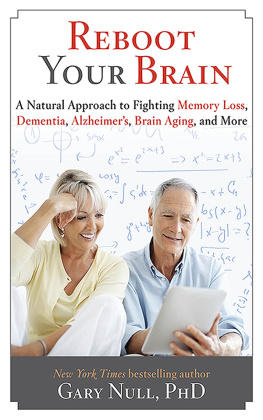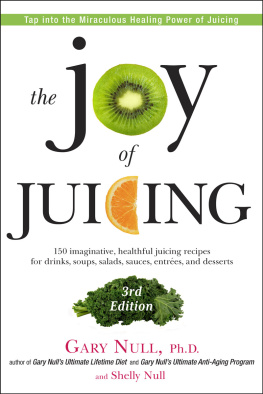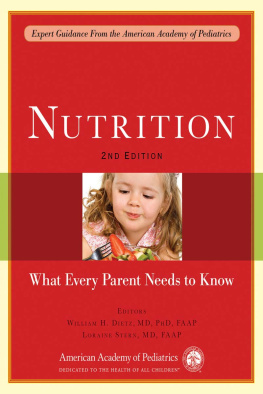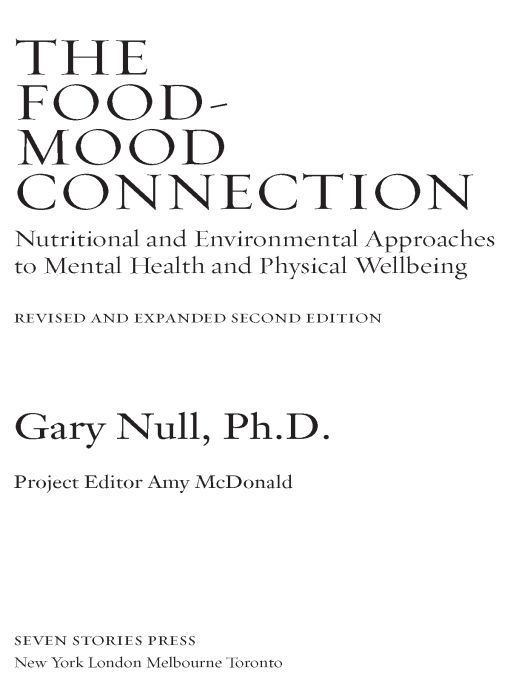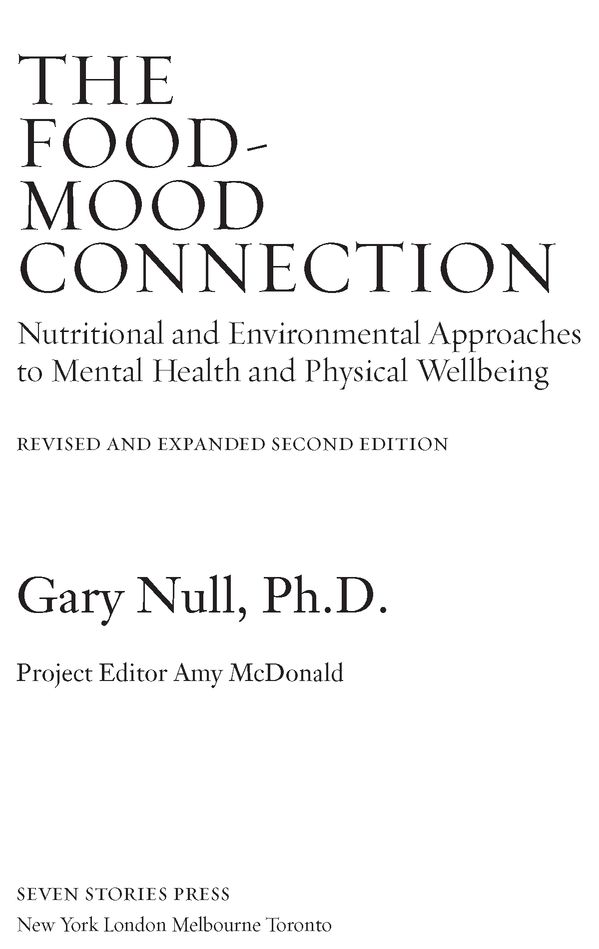Table of Contents
Authors Preface
The information in this book represents nearly forty years of research and clinical experience. In seeking solutions to the complex problems of the food-mood-body connection, I have also interviewed thousands of board-certified clinicians from the fields of immunology, environmental medicine, psychiatry and psychology, as well as other behavioral sciences. From these interviews I have extracted from the clinicians experience the information that is most relevant, and easy to understand and utilize. This provides you with the most up-to-date knowledge of the conditions you have and ways to prevent unnecessary suffering in the future.
Gary Null, Ph.D.
2007
PART ONE
Mental Health in the Twenty-first Century: Crisis or Opportunity?
Hundreds of millions of people around the world suffer from mental and behavioral health problems. Recent estimates are staggering: 154 million people with depression, 91 million with alcohol addiction, 25 million with schizophrenia, 24 million with Alzheimers. Even more staggering is the fact that so many people endure years of chronic debility without ever receiving the help they so desperately need. Although effective treatments are available for many conditionsincluding a plethora of holistic nutritional and environmental therapiesmental health concerns continue to be minimized, ignored, or improperly managed by policy makers, doctors, and the general public alike.
Unfortunately, the situation has not improved over the years. All predictions are that the future will bring dramatic increase in mental problems, says former World Health Organization (WHO) director-general Dr. Gro Harlem Brundtland, who labels mental health a crisis of the 21st century.
According to the World Health Organization Mental Health Atlas, updated in 2005, global resources devoted to mental and neurological disorders remain grossly insufficient to address the growing burden of need. The findings reflect the ongoing reality that the world still considers mental health care as a low priority within public health, says Dr. Benedetto Saraceno, WHO director of mental health and substance abuse. Public health planners and decision-makers need to take the mental health needs of their populations more seriously.
Although the United States devotes more of its health expenditures to mental health than many other nations, the proportion6 percentis meager considering the hordes of Americans affected and the devastating consequences of these disorders. There have been advances, says Dr. Thomas R. Insel, director of the National Institute of Mental Health in a 2006 statement, but mental disorders remain unacceptably common, causing more disability in people under age 45 than any other class of non-communicable medical illness.
Dr. Gabriel Cousens believes that what we are really facing is an epidemic of biologically altered brains caused by nutritional deficiencies. In every generation on a universally poor diet, Dr. Cousens says, there is a successive increasing degeneration in our mental and physical state. This has been shown in animal studies and we are now finding it in human studies. We have at least eight million children on Ritalin. At least 10 percent of our children have hyperactivity. We have 500,000 children on antidepressants, particularly Prozac. One hundred thousand children are active alcoholics. It has to do with the poor nutrition of the parents, which affects the developing brain of the fetus. Then the child is raised on a very poor diet, so the brain, which may be genetically weakened, becomes even more significantly weakened. Their neurotransmitters have lower amounts, their endorphins are not working quite right and so their brain is actually altered to the point where they need to do something to feel okay. That takes us to the epidemic of addictions which are also mental health diseases.
Despite their usefulness in shedding light on a subject still considered shameful, the Surgeon Generals Report, the World Health Organization alarm, and President Bushs commission fall far short of what they might have been. Nowhere do they mention the connection between mind and body, which is the starting point of all holistic medicine. Scant attention is paid to the causes of this epidemic of mental troublenot only depressive illness and addictions, but rising numbers of schizophrenics, children who cant sit still long enough to learn anything in school, and ordinary people unable to focus, sleep, or think clearly. Its taken for granted that our mental capacities weaken as we get older, but that isnt necessarily true. The environmental poisons and nutritional deficiencies that obviously contribute to mental and physical trouble, disease, or deterioration are conspicuously ignored. Even worse, the progress made by orthomolecular doctors and other health professionals still called alternative is missing from the picture.
The national and international experts bemoaning a mental health crisis forgot to consider the good news: most mental and emotional conditions can and have been helped, if not cured, by natural means.
As Dr. James D. Gordon, clinical professor at the Georgetown University School of Medicine says, All aspects of diet can affect all aspects of psychological and emotional functioning, and the fact that the average doctor sees no connection between nutrition and the mind is staggering. Were not used to understanding the power of food in every healing tradition in the world. Hippocrates said Let food be your medicine and medicine your food. But when we think of putting something in our mouths to affect our health, the reflex is to think of drugs.
Dr. Abram Hoffer, a pioneer in the field of orthomolecular psychiatry who specializes in schizophrenia, believes his colleagues in the mental health field are way behind general medicine, but theyre going to have to start budging. We in psychiatry are at least 10 years behind the rest of medicine when it comes to the proper consideration of nutrition, nutrients and other factors in the treatment of mental illness. Theyre still using treatment that was considered pretty good 30 years ago, and the only treatment today for schizophrenia is one of a variety of tranquilizers. As new ones are produced, they generate tremendous excitement as if a new tranquilizer is going to do a better job. Some of them are also very dangerous.
Dr. Hoffer uses his experience with schizophrenia to illustrate. Standard psychiatry merely gives every schizophrenic patient one or more tranquilizers in varying doses and hopes that this will bring the disease under control. If they get well, they start to get side effects, so they cut down the tranquilizer dose, and when they do that, the disease comes back, so the patients are bouncing back and forth between the street and the hospital, between high dose and low dose, between sickness and health. You can see the result. I would guess that half of all the homeless people in North America probably are schizophrenic patients who should have been treated in a hospital and kept there. Most psychiatrists want to put their patients on a tranquilizer on Wednesday, they want to see him better on Thursday, and they want to discharge him on Friday. You simply cannot get a chronic schizophrenic patient well that fast. It takes a lot of time.


